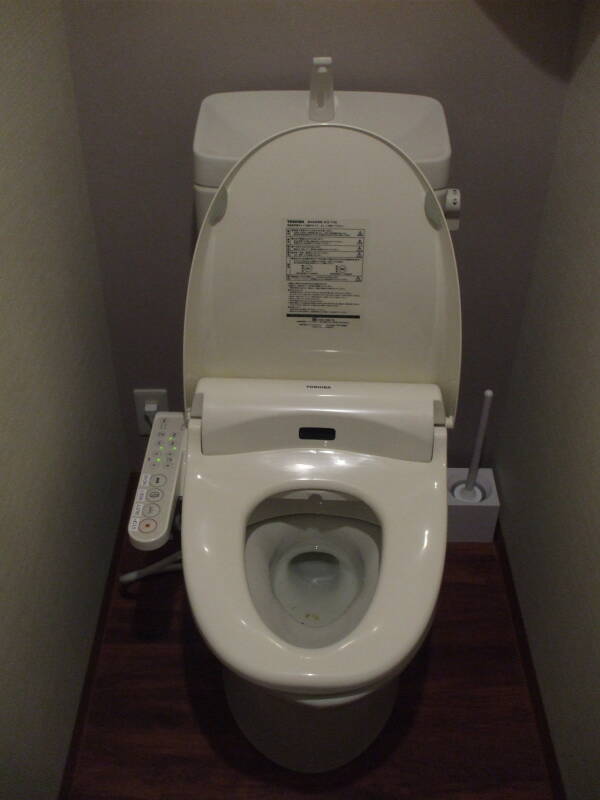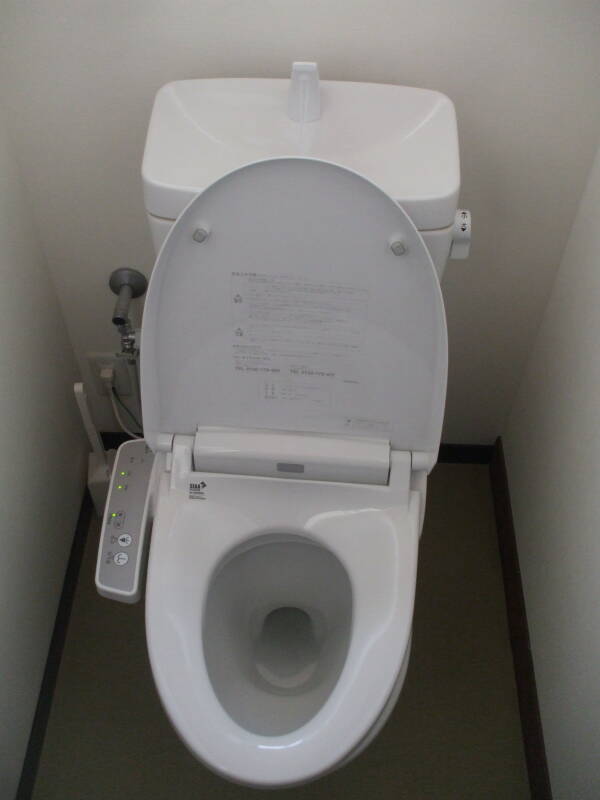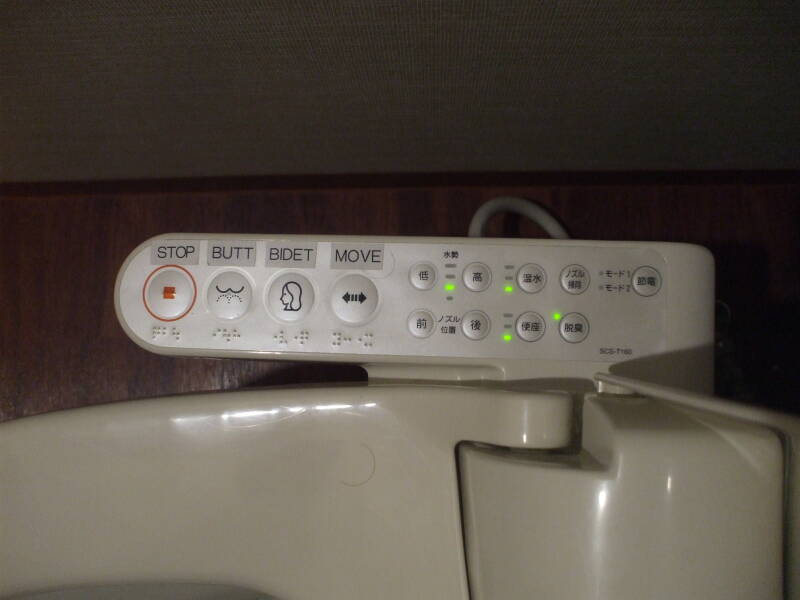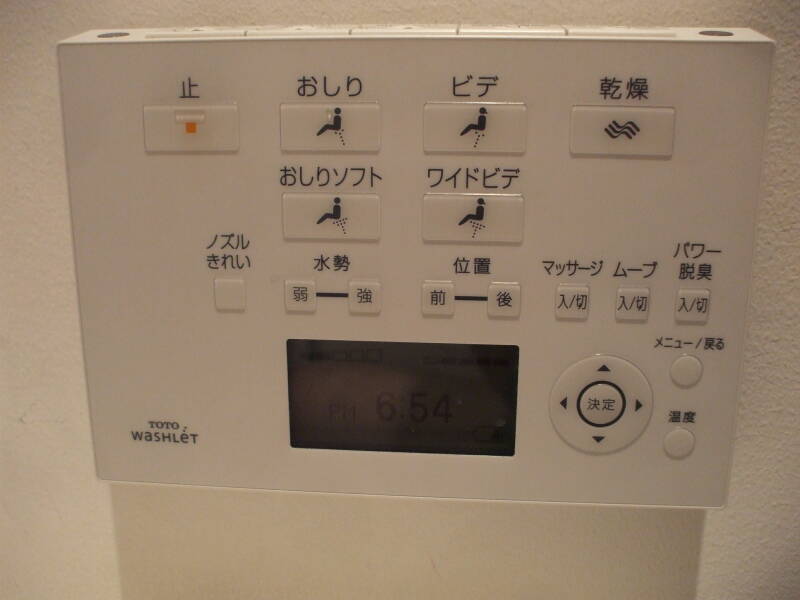
Futuristic High-Tech Toilets
The Toilets of the Future Have Arrived
What will toilets look like in the future? As William Gibson has observed, "The future is already here — it's just not very evenly distributed." Toilets of the future have been here for some time, and I have encountered a few of them. These stunningly futuristic facilities are the antithesis of much of the rest of my collection.
Doctor Toilet Will See You Now
June 2020 brought the publication of "A mountable toilet system for personalized health monitoring via the analysis of excreta" in Nature Biomedical Engineering, written by a team from Stanford University, Seoul Song Do Hospital, Case Western Reserve University, Leiden University, Pohang University, the Catholic University of Korea, and, somewhat alarmingly, Salesforce Research.
They outfitted a bidet seat with a variety of sensors. It can automatically subject urine to 10 biochemical measures in addition to measuring the flow stream; time the beginning and length of defecation, and classify the stool as per the standard Bristol Stool Chart.
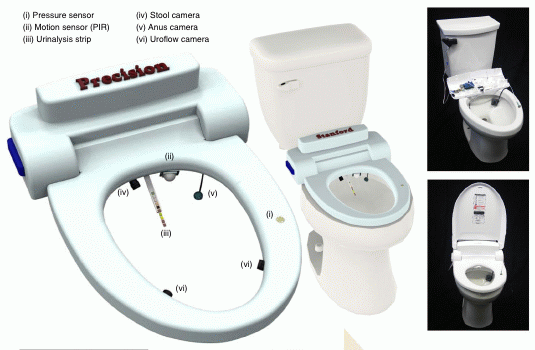
Toilet device with health examination system US4962550
Toilet with urine constituent measuring device US5730149A
Toilet-bowl-mounted urinalysis unit
A Japanese company has pursued the concept since the 1980s and has published several patents. However, it costs US$6,100 and lacks clinical utility. This research is more promising.
They placed a fingerprint scanner on the flush lever. However, a toilet might be flushed by someone other than the original user. And, automatically flushing toilets are becoming more common.
So, they recognize the user by what they describe as "the distinctive features of their anoderm." That is, their anal creases, or what they call the analprint. A camera off to the side captures that.
Uroflowmetry, measuring the velocity, volume, and duration of urination events, is done with a pair of high resolution, high speed cameras. 1280×960 pixels, 240 frames per second. They measure the 3-D shape of the stream and its velocity.
Urine is analyzed with a ten-parameter urinalysis test strip which is extended into the stream with a stepper motor. It provides qualitative and semi-quantitative measurement of erythrocytes, urobilinogen, bilirubin, protein, nitrite, ketones, glucose, pH, leukocytes, and specific gravity. The result is examined with a color camera, and then discarded into the bowl.
A rear-mounted camera analyzes waste in the bowl, assigning it to the Bristol stool form scale.

Amazon
ASIN: B06XXSRDCC
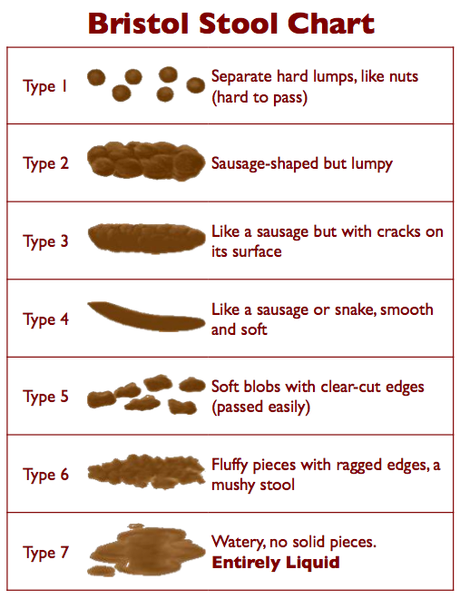
Amazon
ASIN: B07Q3SK9CV
There is no "gold standard" of Bristol stool classification. It's not like a quantitative biochemical test, it's a subjective judgement of appearance. So, they asked two board-certified surgeons in the subspecialty of coloproctology to classify examples of the seven Bristol types. The two specialists were mostly, but not precisely, in agreement. The research team then used that data plus images of clean, urine-only, and toilet-paper-only bowls, to train an Inception CNN or deep convolutional neural network machine learning system.
Then they compared the machine learning system to the performance of medical students. They would be shown examples the experts had classified. The students had all completed at least two years of medical school training. The machine learning system out-performed the students who had not yet been trained specifically on grading stool, and did as well as those who had received that training.
They also performed a survey in the Stanford University community. More than half of that highly educated group reported being "somewhat comfortable" (37.33%) to "very comfortable" (15.33%) with using the toilets, while 30.00% said they would be "uncomfortable". The concerns focused on privacy and data security. The urinalysis was the most accepted component of the system, the analprint was the least so.
Islamic ToiletRegulations
They still have work to do. The urinalysis and uroflowmetry only work for standing male users. The urine measurements don't work for sitting users, which would also include many male Muslim users.
The authors mention that they used a sitting or western style toilet, not a squat toilet. However, squat toilets are often used by populations who are most in need of basic sanitation and the prevention of infectious diseases. Approximately one billion people in the world with no toilet at all, and are forced to defecate in the open. They simply need functioning toilets. Medical technology additions can come later.
Another planned improvement is to use sonouroflowmetry, using ultrasound to estimate urine flow rate and volume without imaging the users' genitals.
Of course NASA has looked into automated human waste analysis. NASA helped with the set design of The Martian, including the toilet in the Mars habitat.
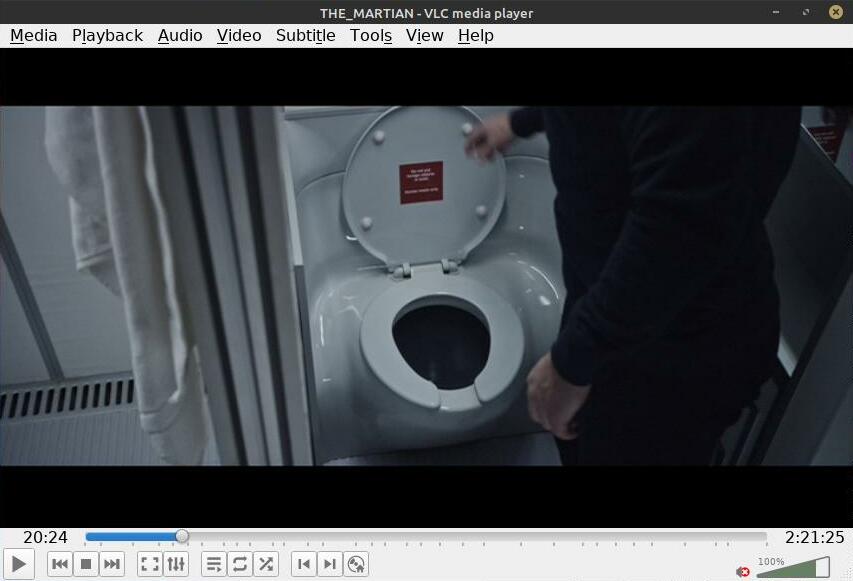
Each astronaut's waste is collected and analyzed to track their health.
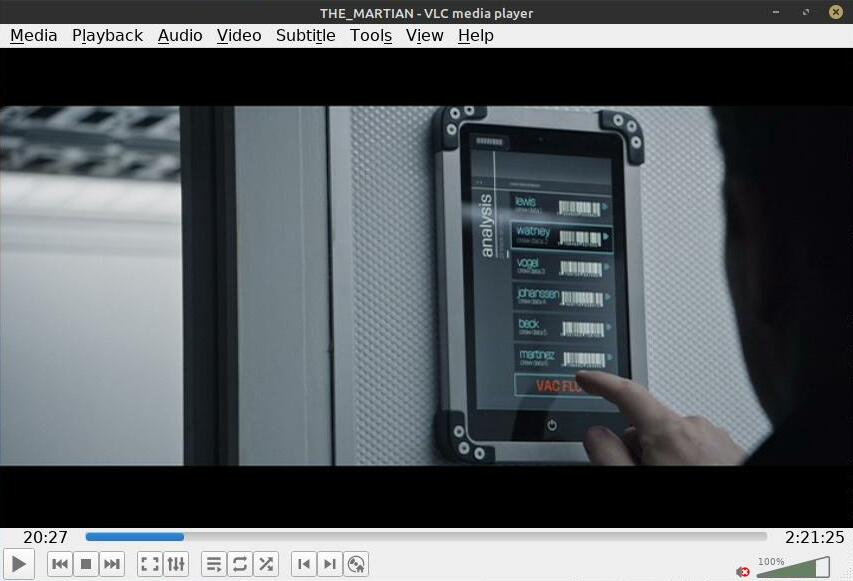
France and the Sanisettes
Automated public toilets were invented in France and installed in public some time probably around 1990. The design has since been exported to other countries. This first one is a classic unit in Paris.
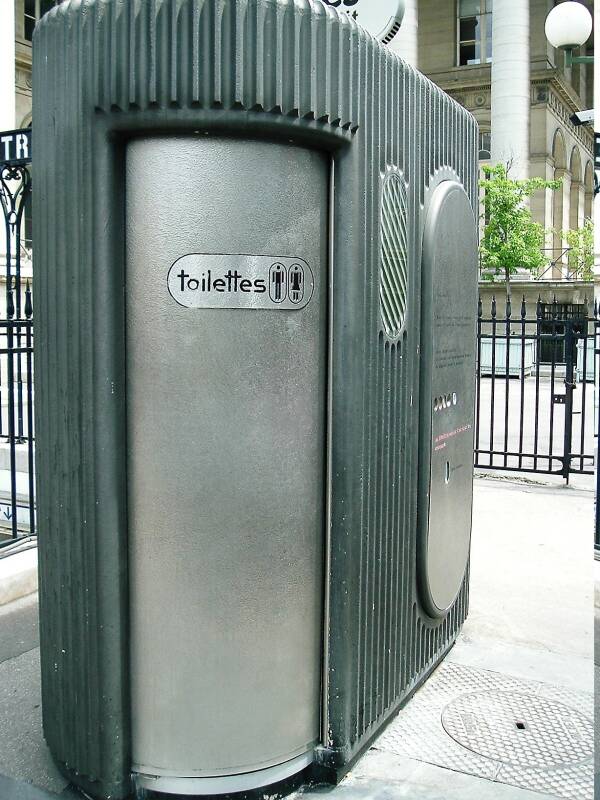
The French company JCDecaux developed these self-contained self-cleaning public toilets. They registered the trademark Sanisette in 1980.
PissoirsAround 1770 M. de Sartines, the lieutenant general of the Paris police, ordered that the "barrels of ease" at many street corners be taken away.
In 1839 Claude-Philibert de Rambuteau, Préfet de la Seine and thus effectively Mayor of Paris, introduced the first public semi-enclosed urinals in Paris. There were over 400 within four years, and over a thousand by 1900. They were built of cast iron and painted dark green. During the German occupation of 1940–1944, the French Resistance used them as rendezvous points to pass messages, supplies, and small weapons.
The pissoir inventory of Paris had reached its peak of 1,230 in the 1930s. Continued worry about their use for gay sex led the authorities to dismantle some. In late 1959 the Conseil de Paris was controlled by right-wing politicians, and they voted to remove all of the public urinals.
Complete removal would obviously lead to an enormous increase in public urination. Public outcry lead to the repeal of the right-wing total ban on pissoirs in early 1961, but the number continued to decline. There were just 329 in 1966. And, they were only for men. There had been attempts to build chalets de nécessité and lavatoires souterraines, but there were very few and none were being built.
Jacques Chirac was elected Mayor of Paris in 1979. The first four Sanisettes were authorized in 1980. In 1981 his administration voted to replace all basic pissoirs in Paris with the new Sanisettes. They would be enclosed and have a seat, so women could use them. They would automatically clean themselves after each use. And, you would have to pay to use them.
The older design, seen above and on the inside below, had an unusual design. The bowl is literally a bowl, with no drain. When you exit the Sanisette the bowl slides back into the rear wall and is tipped up and sprayed to wash it out. The seat is a pair of rails on either side of the bowl. Everything inside is wet.
It isn't a pleasant place to sit, but at least it's something.
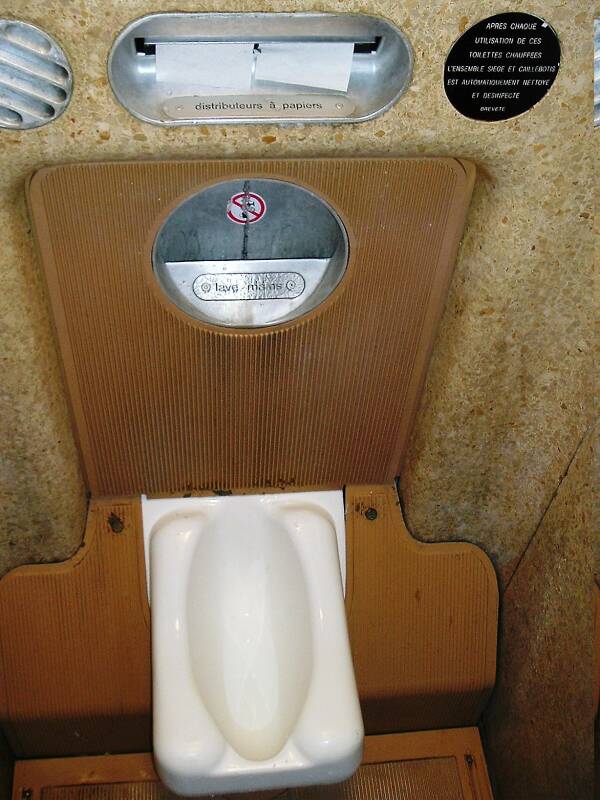
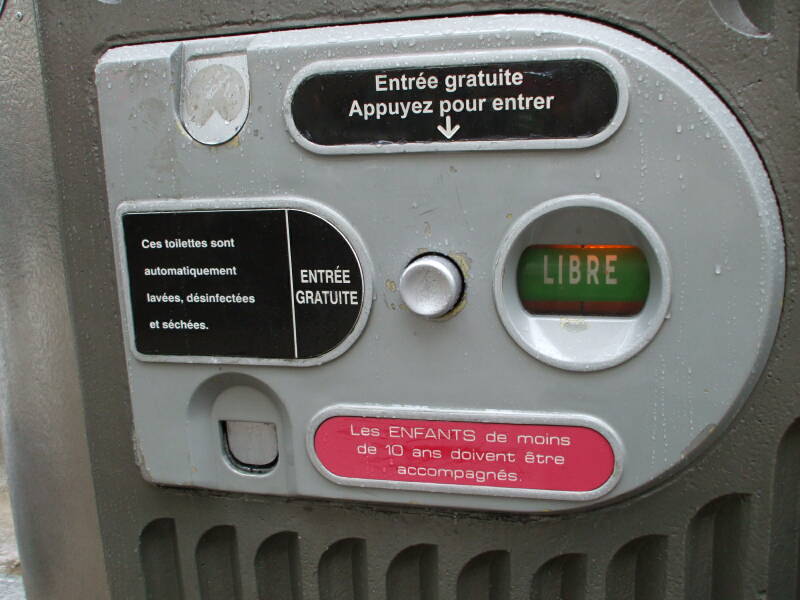
In 1991 the City of Paris signed a contract with the Decaux company. The city pays about €1,200 per month for each of the 420 Sanisettes.
The toilet design has changed over time.
Entrée gratuite or free entry, they say. Originally they cost a few centimes, but now they're free.
About a dozen Sanisettes were converted to free operations in 2003, near areas where homeless people congregate. In 2004, the 110 in the city's parks and gardens were converted. And in February 2006, the City of Paris decided to convert all Sanisettes to free operation. It took until 2014 to finish the conversion.
Wait until the green LIBRE or FREE indicator shows. That's "free" as in libre or unoccupied, and not as in gratuite or no fee. All of them are gratuite all the time, but they're only libre when no one else is already inside. Then press the button and the door opens.
This next one shown below is in the Pigalle district of Paris, just below Montmartre. It is of a newer design, which began replacing the older ones in 2009.
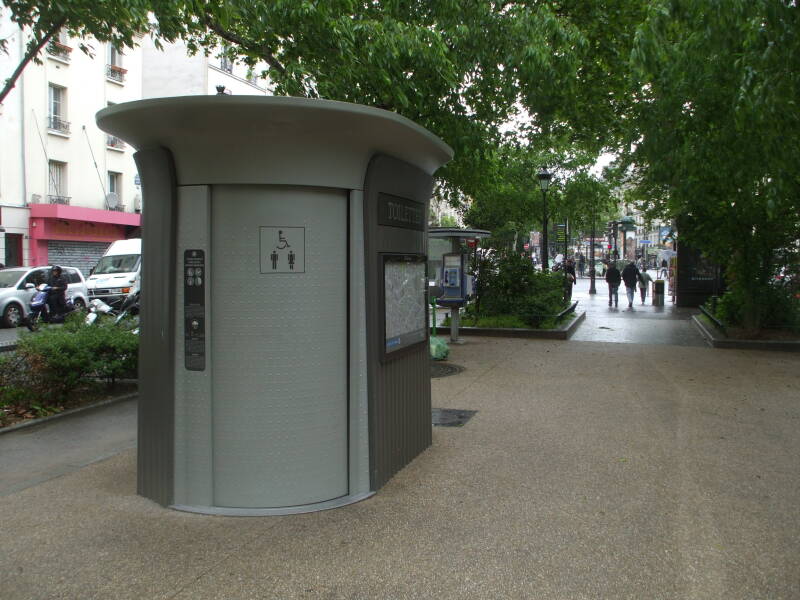
Here are two Sanisettes photographed in 2008. The first has the old simple bowl.
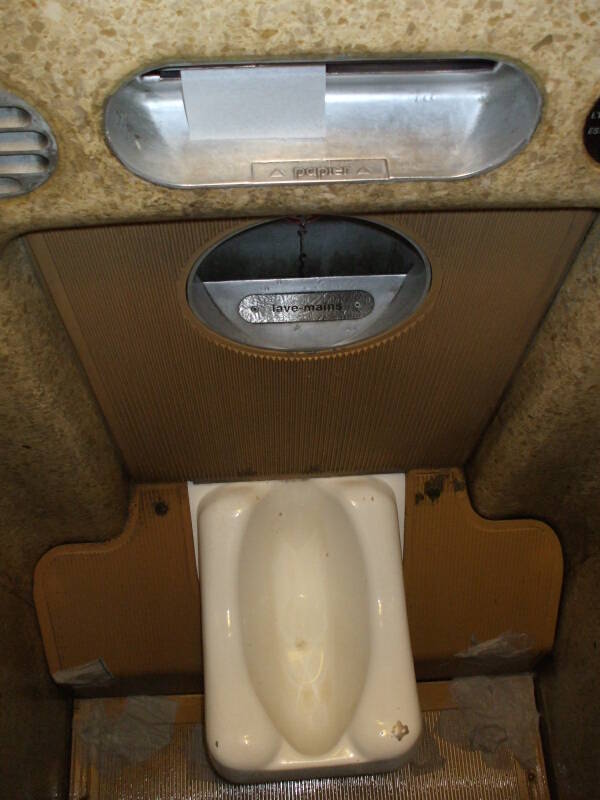
This slightly newer one has a more conventional looking bowl. But the bowl is still retracted and sprayed down after every use.
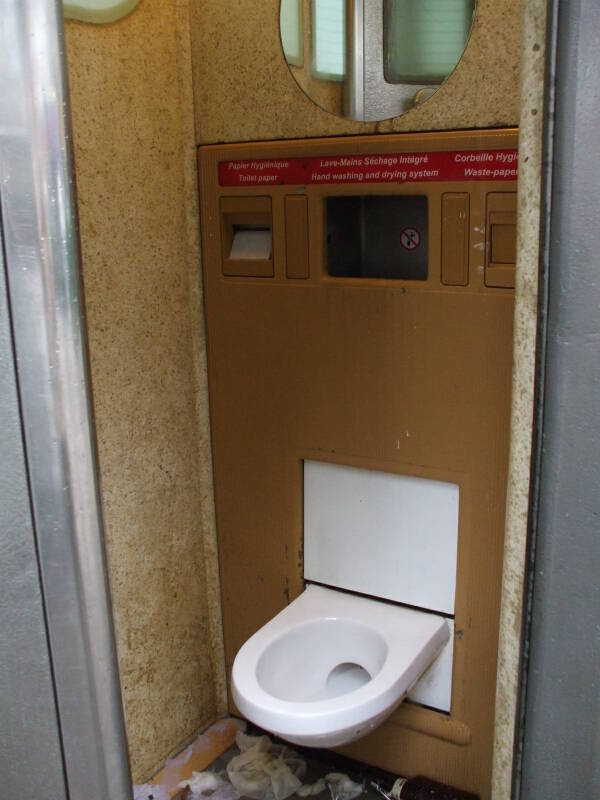
Compartments on the panel above the toilet dispense toilet paper and provide water, soap, and hot air for hand cleaning.
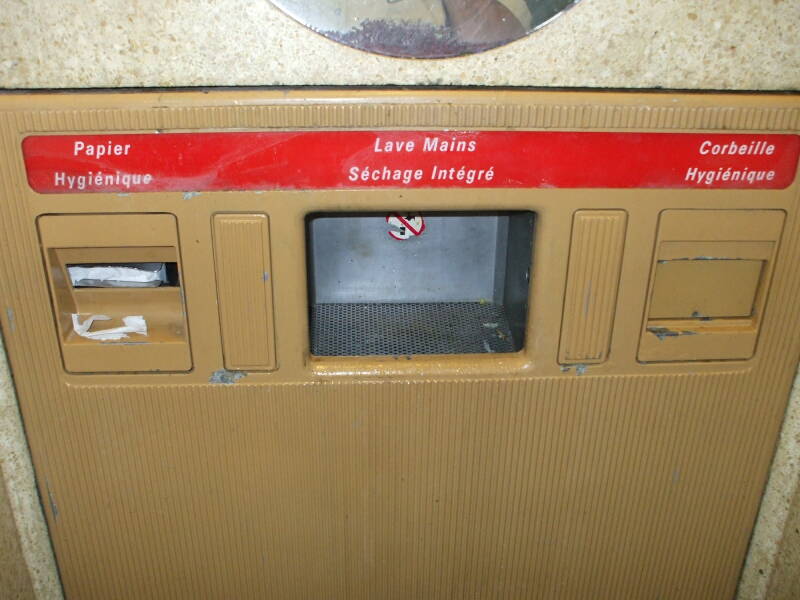
A floor sensor detects whether a person is really inside or not. If there is no person, or after a period of time even if there is a person, the door automatically opens.
After the person steps out, the door closes and the entire interior is sprayed with a disinfectant. The toilet bowl is rotated back into the wall and hosed out. After this quick cycle of 60 seconds or less, it is available for the next user.
Many boat builders have begun using high-tech toilets in their bathrooms since owners travel for so many days. Many sailboats for sale in places like France need to have their waste tank pumped every week so the toilet doesn't overflow.
This Sanisette along the Canal Saint-Martin in Paris shows the state of the art in 2019. The doorway is broad with a small sill, so a wheelchair can enter. The sink is fairly conventional. But the toilet still retracts into the wall to be sprayed and disinfected.
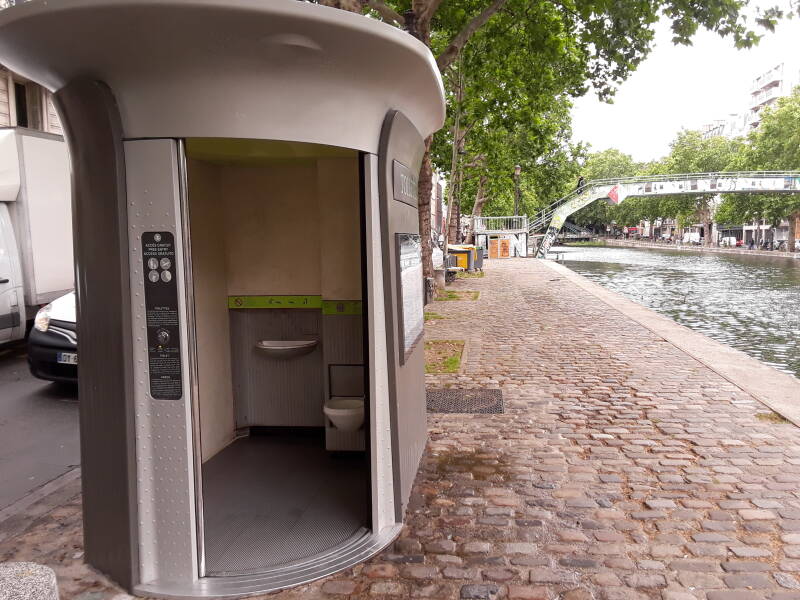
San Francisco, America's most European city in many ways, has a number of the French design automated toilets.
Here's one undergoing maintenance on the Embarcadero, the waterfront facing central San Francisco Bay and the Bay Bridge to Oakland. That's the Coit Tower up on Telegraph Hill in the background.
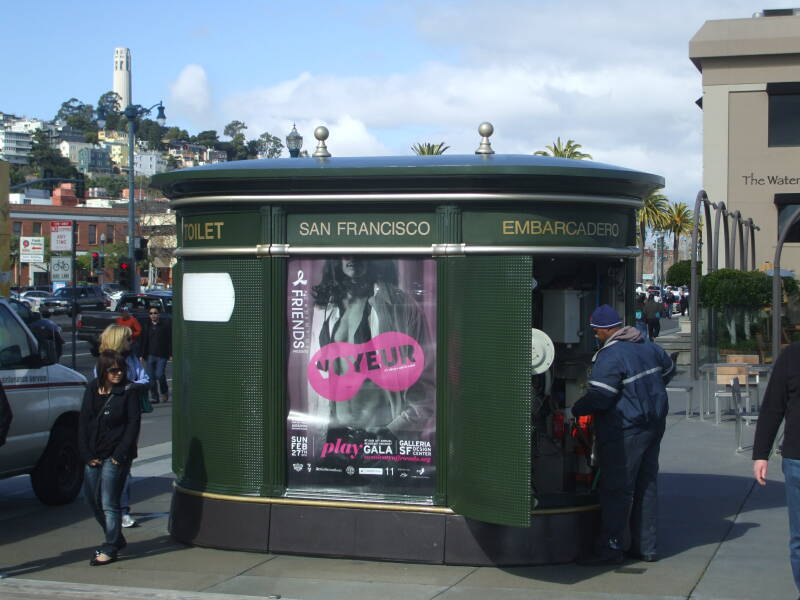
This man is working on this one. Let's see if we can get a look inside the mechanical back end!
After all, the advertising poster on the side does say "Voyeur".
The back end contains a mixture of electrical, water, and waste hardware.
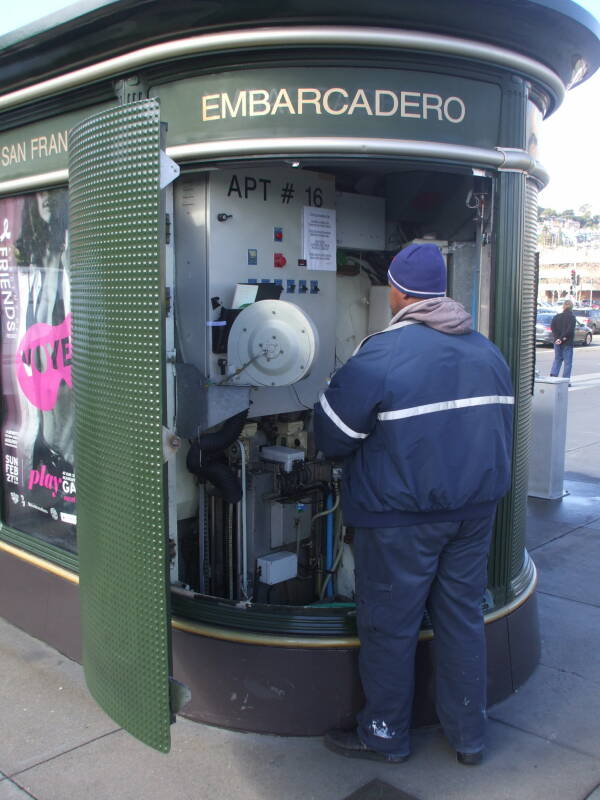
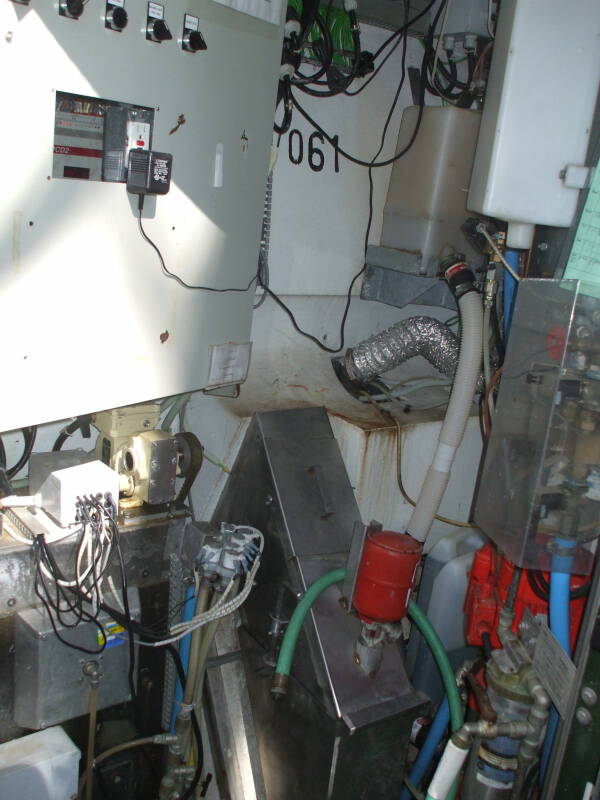
Here is the entry to another automated unit in San Francisco. This one is at the base of the Coit Tower.
The internationalized signage indicates it's good for individuals and groups of two, smoking is not allowed, and it will automatically open in 20 minutes.
The fine print describes all that in more detail in a variety of written languages.
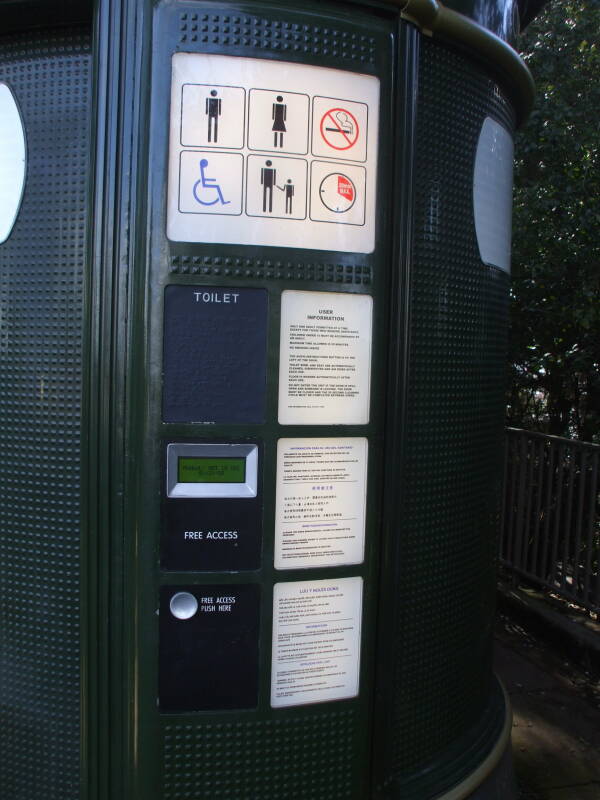
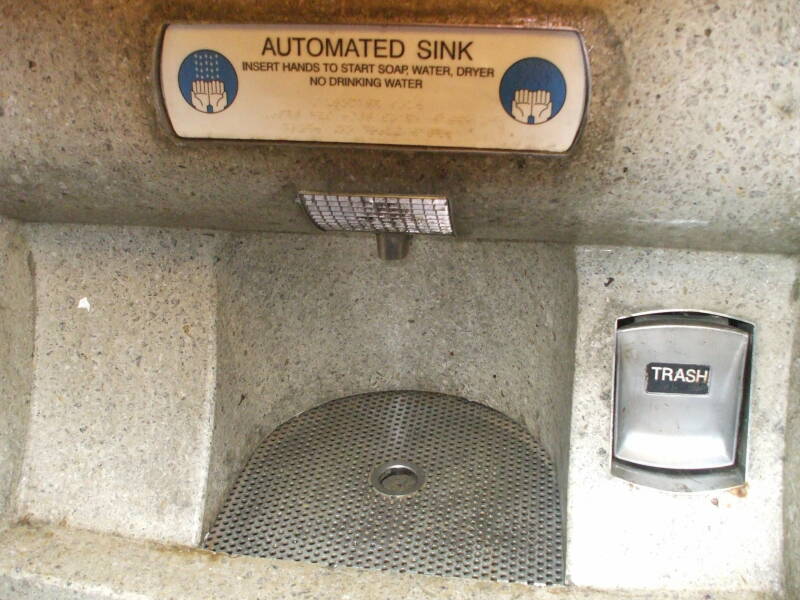
Much of the interior is cast in a speckled plastic. The automated sink says:
AUTOMATED SINK
INSERT HANDS TO START SOAP, WATER, DRYER
NO DRINKING WATER
This toilet has the more traditional design with a drain, it's not the simple bowl of the early French designs. This is made of stainless steel, the early and middle French designs used a white plastic material.
The bowl rotates back ninety degrees during the cleaning cycle and is cleaned by being sprayed from the rear.
The floor and some of the lower wall surfaces are covered in a tough corrugated rubber material. You can see the speckled plastic on the wall at right.
You might notice that the floor feels a little springy in these automated units. It's a weight sensor. The entire floor functions as a crude scale to determine if it is actually occupied. If someone starts the cycle and steps out before the door closes, it will quickly re-open.
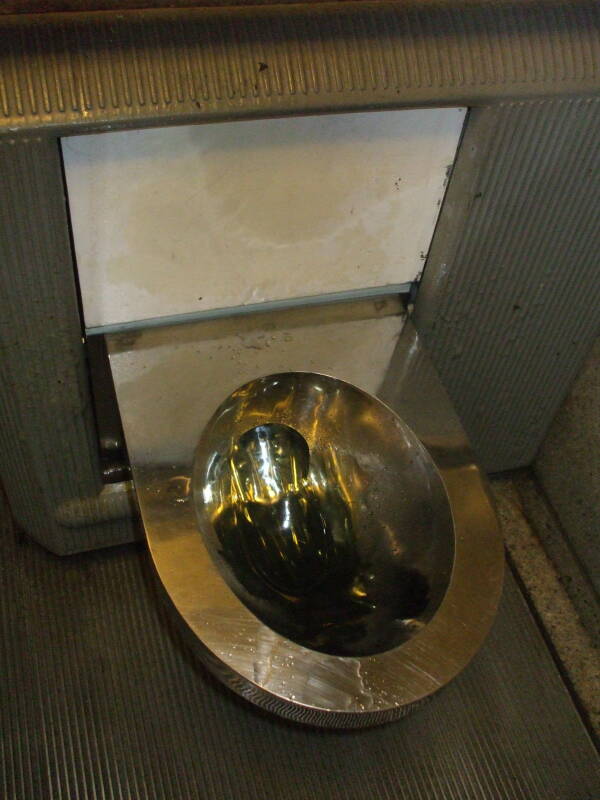
Reykjavík, Iceland has some of the automated public toilets first developed in Paris.
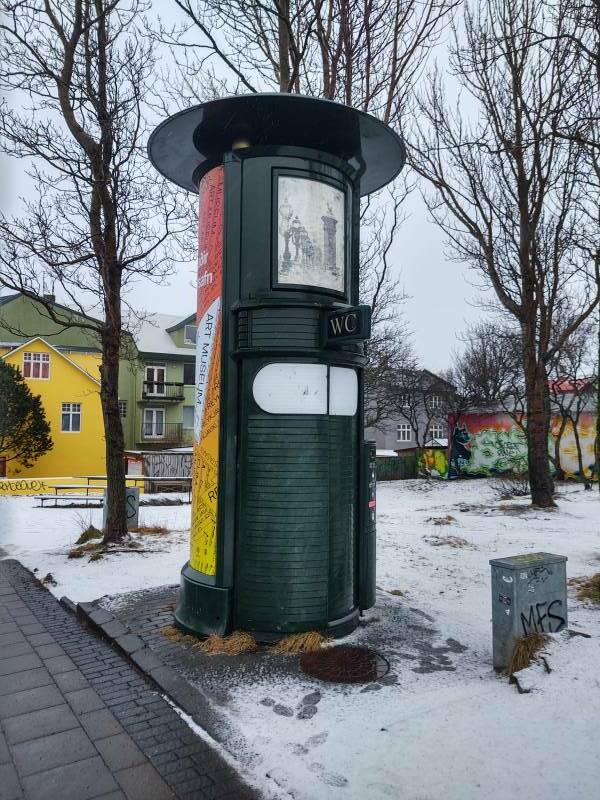
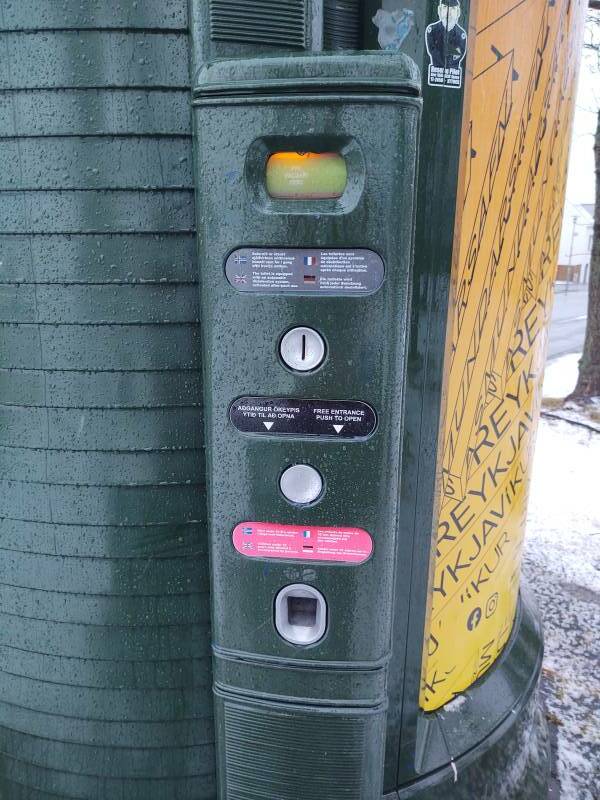
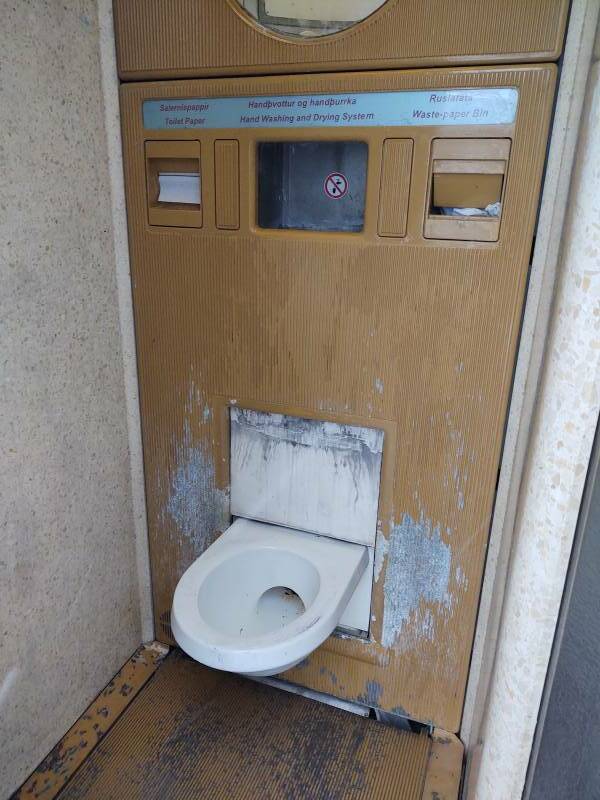
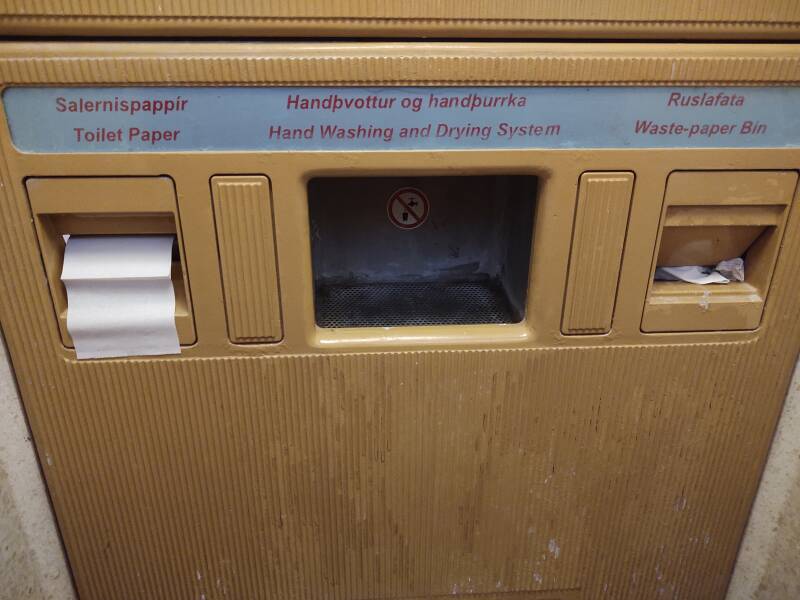
This is a Toilette a Grande Vitesse, or a High Speed Toilet, found on the TGV or Train a Grande Vitesse, the High Speed Train running through France.
Before leaving my seat, my GPS had synced up and was indicating a speed of 305 kilometers per hour.
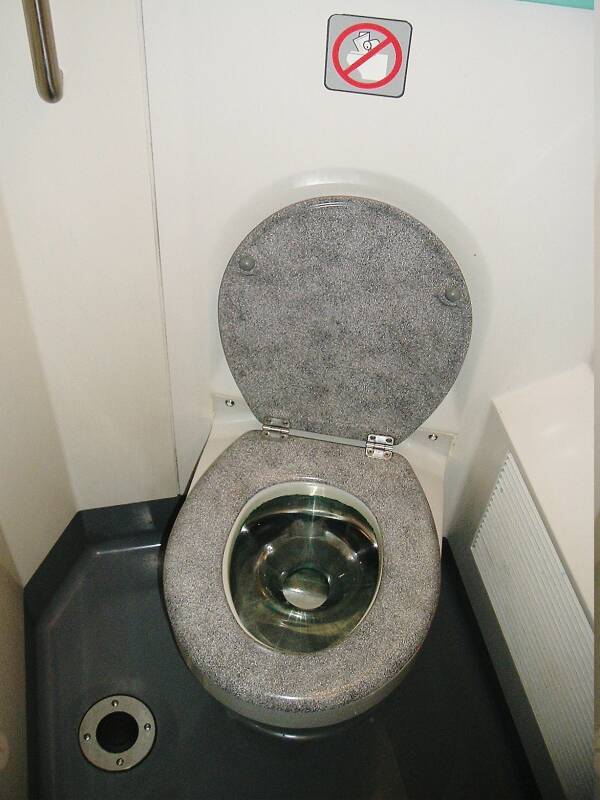
Japan
Japan has led the world in sophisticated toilet design for a few decades now. By the mid 2010s, almost all raised commodes in Japan had multi-function seats with heated surfaces and rear and front washing bidet functions. Several also include control of the spray temperature and intensity, air drying, and even "cover noise" to obscure what you're up to.
The control panel may be on a small arm next to the seat, or it may be mounted on the wall.
These two are in the Khaosan World Asakusa Ryokan and Hostel in Tokyo, and the Hiloki Hostel in Nara.
Here is a toilet on board the Shinkansen, Japan's wonderful high-speed train, on a trip from Osaka to Tokyo.
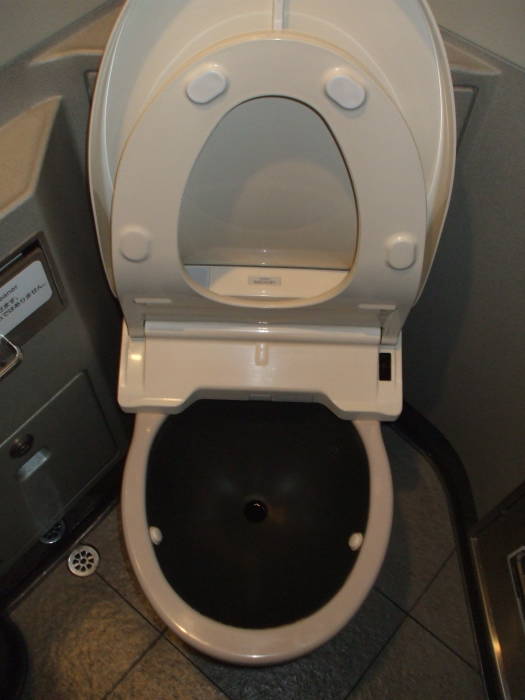
Waterless Urinals
Waterless urinals used to be exotic, but they're becoming much more common. The first one of these I saw was at Fort Huachuca, in south-eastern Arizona. It featured an eye-level explanation of how the things work: Teflon-like non-wetting surface, a collection vessel with a layer of light oil so the urine collects below a sealed oil surface. However, as Fort Huachuca is where the US Army does its intelligence training, it's not the best place to be taking pictures.
Taking pictures in public restrooms is bad enough, but taking pictures on intelligence bases is even worse.
I had to wait until spotting this one in the Dark Horse Tavern along North Highland Avenue in the Virginia Highlands area of Atlanta, Georgia, USA, to collect an image of a waterless toilet.
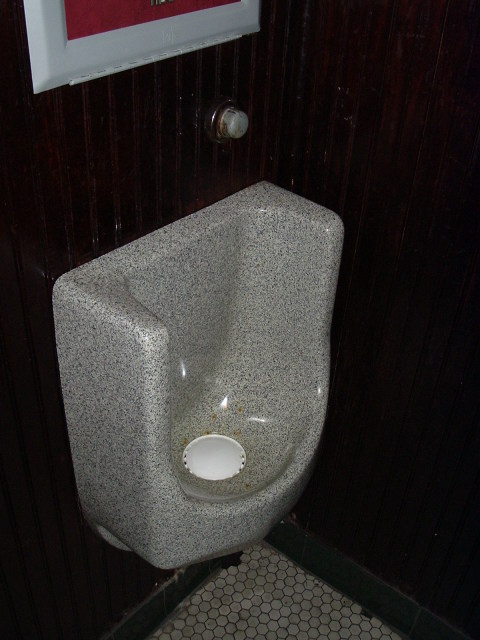
Below is a pair of waterless urinals. Unlike the above, with its marble-flecked plastic material, this Sloan Waterfree unit appears to be traditional porcelain, although probably with a teflon-like coating on the, ah, active surface, shall we say.
This waterless urinal pair is found in the American Tap Room bar in the Reston Town Center in Reston, Virginia, USA.
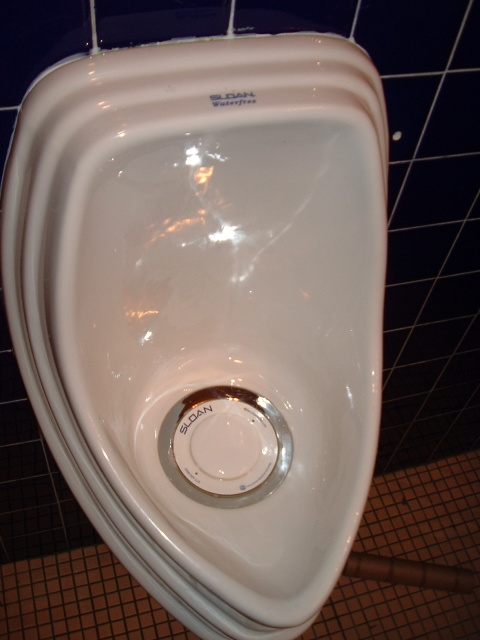
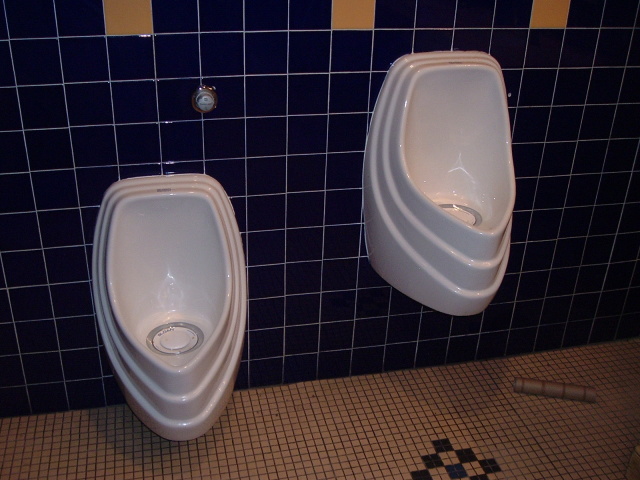
This free-standing waterless urinal is at the Pasara Thai restaurant at 2501 Jamieson Avenue, Alexandria, Virginia, USA. This is in the Carlyle area surrounding the U.S. Patent and Trademark Office.
Identical Kohler models can be found in the international concourse of the Atlanta airport.
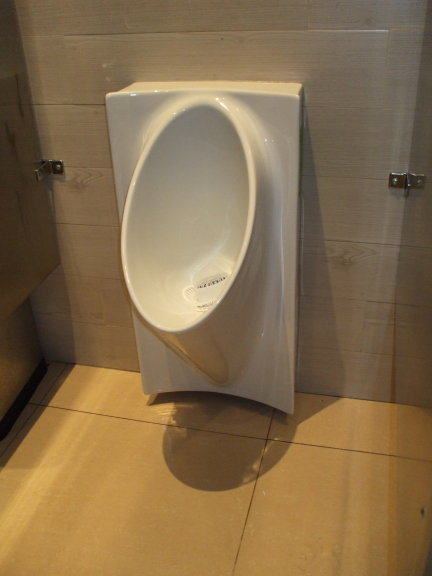
Failures of High Technology
O'Hare Airport (ORD), outside Chicago, USA, contains abominations called "Sani-Seat" toilets.
Least. Comfortable. Toilets. EVER.
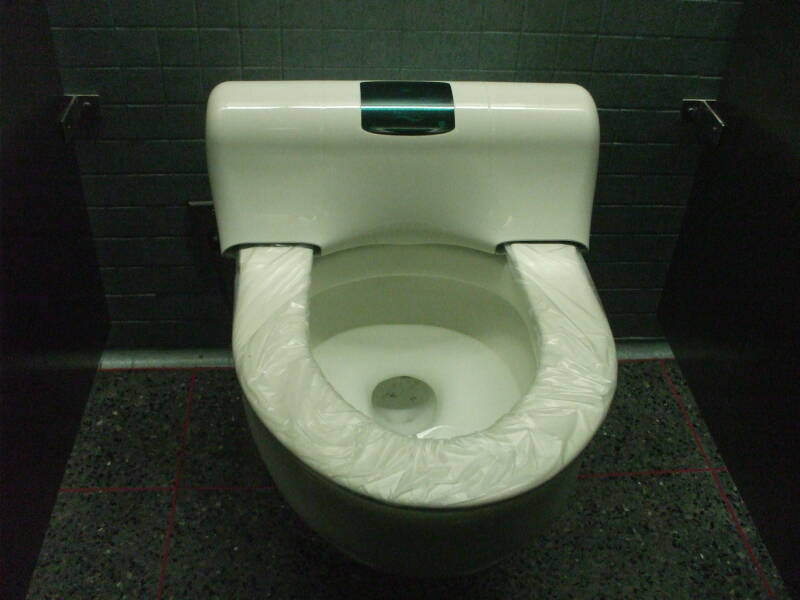
The seating surface is narrow and flat with squared off edges. It's somewhat like sitting on exposed rafters during a construction job. Except that it's not that comfortable.
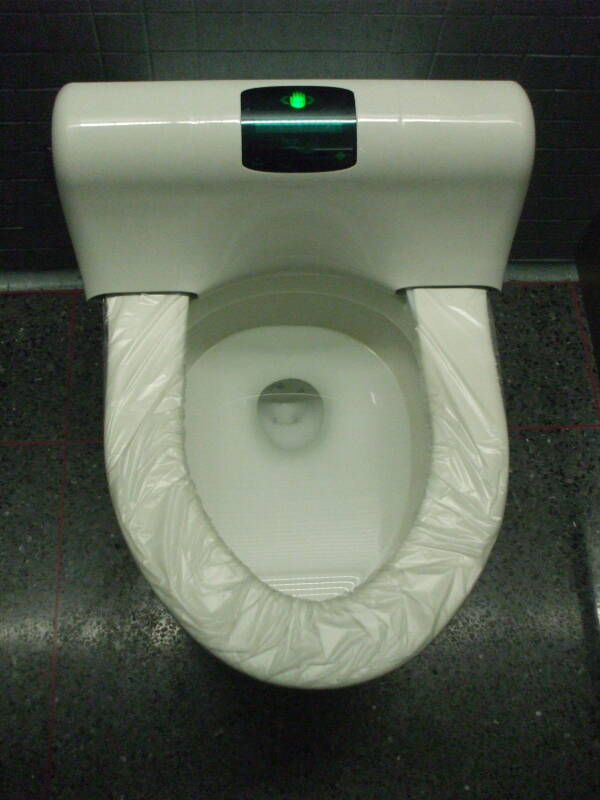
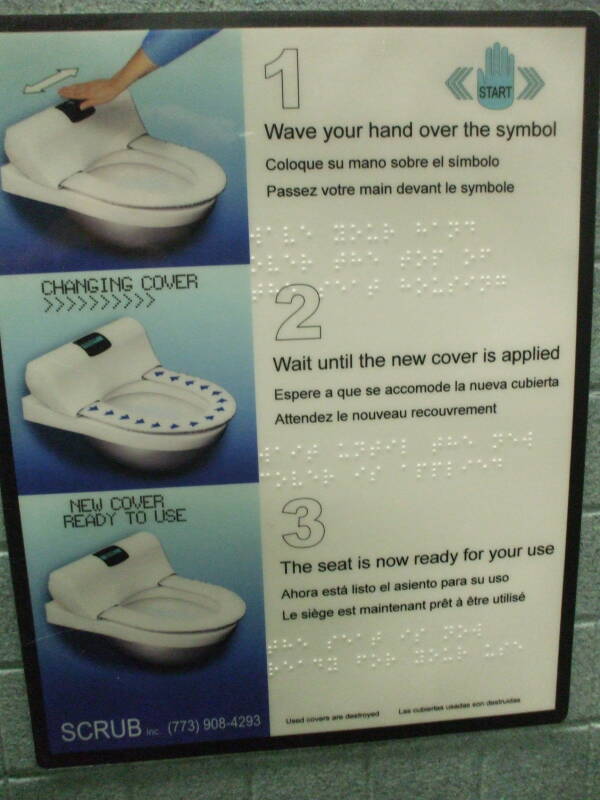
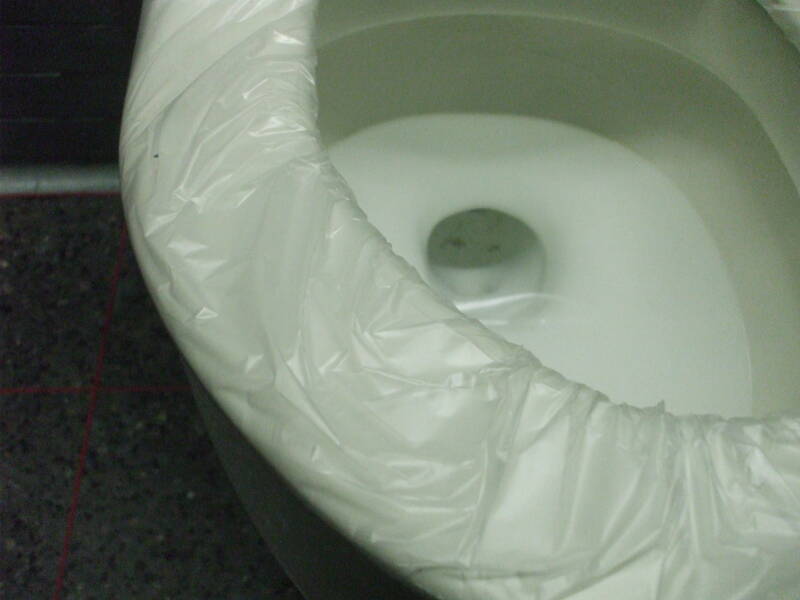
What are these like for the user?
Imagine starting with the least comfortable toilet seat shape ever designed, and then wrapping it in crinkly waxed baking paper.
It's like that, except less comfortable.
Cambridge University
Toilets of Higher EducationThis high-tech urinal is in the park adjacent to the campus of Cambridge University. The hand-washing water flushes it, and there is a (nearly hidden) hot-air hand drier also built in.
This is not handicap-accessible, so this is not Steven Hawking's personal toilet. He is on the faculty there, having held the position once held by Isaac Newton.
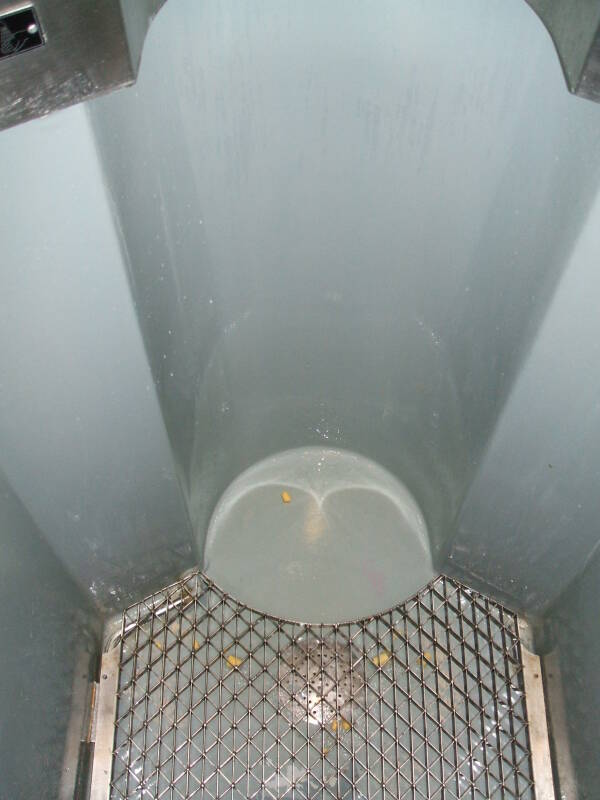
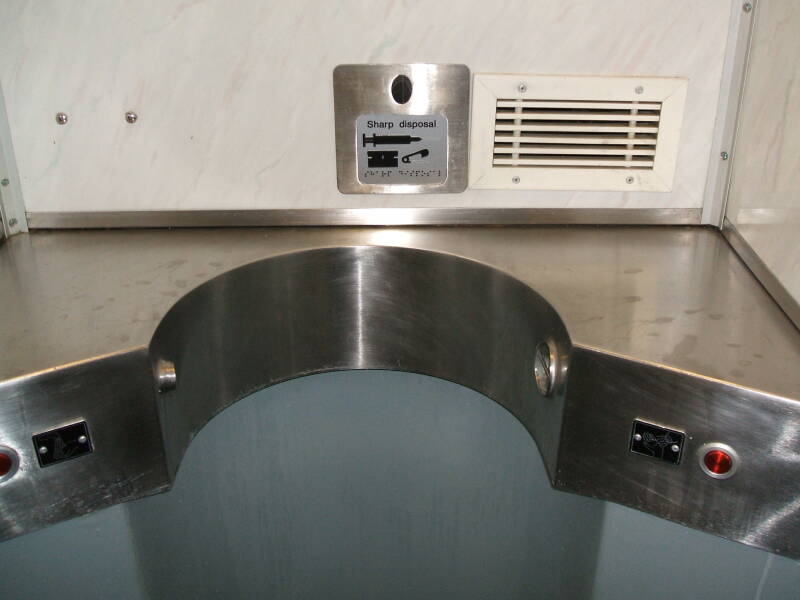
Boston
Below is a slightly different waterless model, featuring the fly image pioneered by the urinals at Schiphol Airport outside Amsterdam. It's actually a bee in this example, click here to see the famous Schiphol Airport urinals. A small target on which to concentrate? A distraction? Whatever the mechanism, it is said to significantly improve cleanliness.
Somewhat ironically, this high-tech urinal was spotted in the Hand and Bell Tavern in Boston, which claims to be the oldest bar in the U.S., dating from 1795.
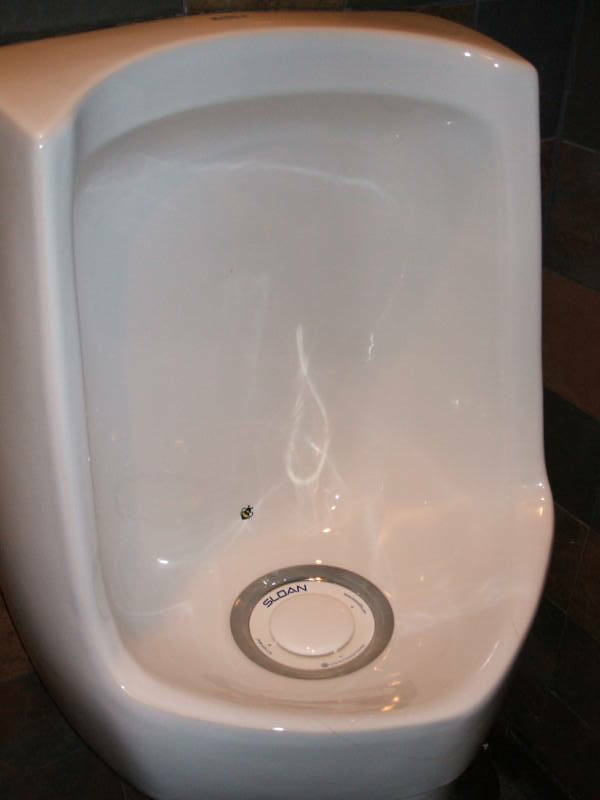
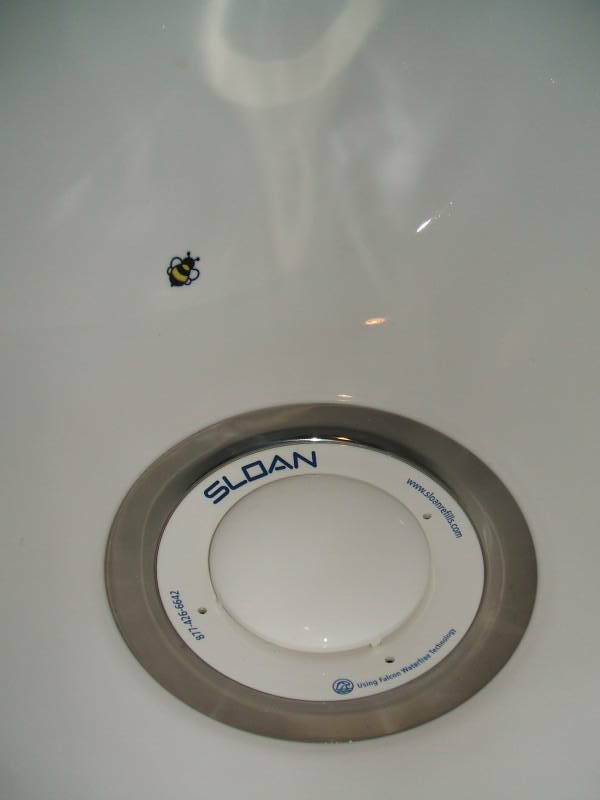
This super-fancy bathroom is in the Ambassador Suite in the Westin Boston Waterfront hotel, Boston, Massachusetts, USA.
When you turn on the bathroom light, a television set embedded behind the mirror turns on. And there is what appears to be an Ethernet jack in the wall above the handrail next to the toilet!
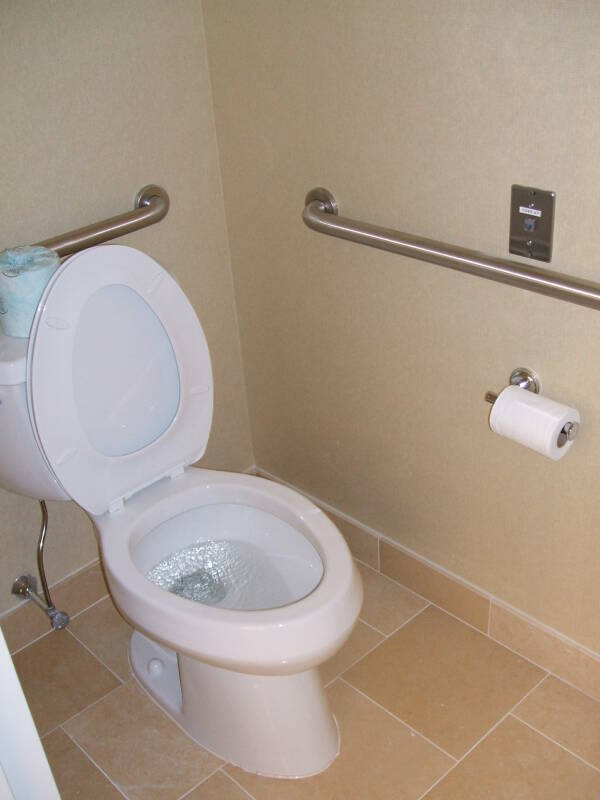
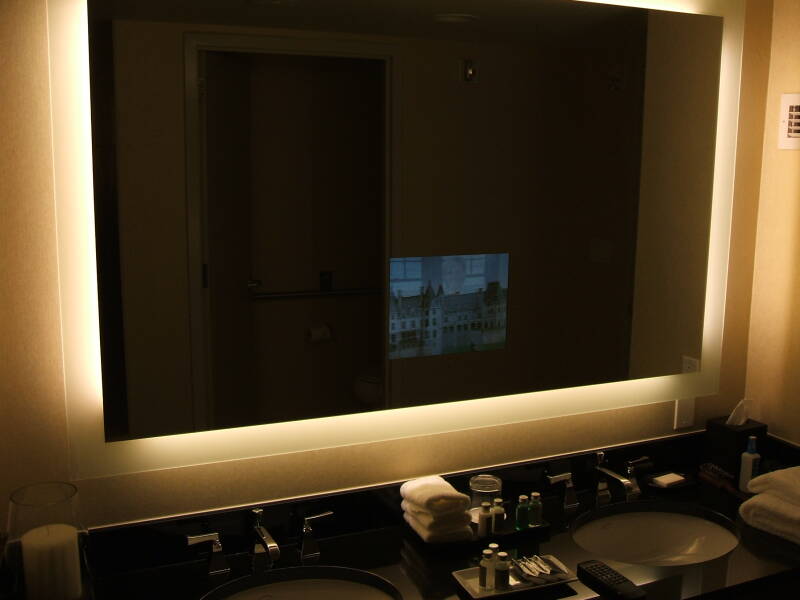
However, the Westin Boston Waterfront hotel has horrible service. I was there for two weeks while working at a conference (although not staying in the suite shown above!). Don't stay there, this hotel is awful:
- One evening the bellman pushed our group into a dangerous van instead of the taxi we had requested. The driver did not know where we were going, and then asked for $50 for a one-mile trip. Half the seats in the van had their backs broken off, and the roof-mounted air conditioning unit sprinkled water through the back half of the van.
- Our used damp washclothes were left to pile up in the bathtub, and we had to go downstairs to ask for replacement bottles of shampoo multiple times during our stay.
- The concierge was so unfamiliar with the area that he could not even tell me where a mailbox was located.
- This hotel is so petty and fixated on taking the guest for everything possible that they even bill for placing toll-free calls! And, there is no warning in the room that they are going to charge you for this. I questioned this at checkout and a staff member angrily snapped at me, "All hotels do that!". No, they don't, just the rude ones.

